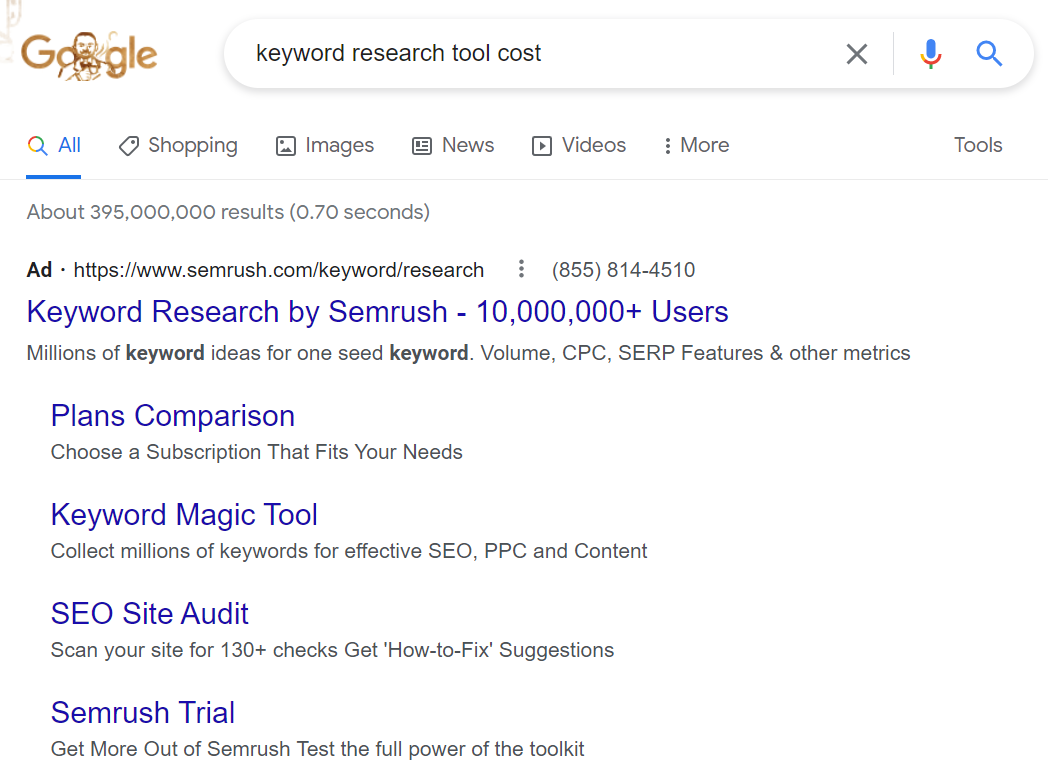The basic definition of ad rank has not changed over the years.
Ad rank is the value that determines your ad position on Google Search, relative to other ads.
While we all know that ad rank is the main factor in your ad positioning, what exactly are those factors?
What goes into the calculation of ad rank? What can you control to improve your ad rank?
If you’re not sure where to start with ad rank, this is for you.
While ad rank may seem like a simple calculation, it can feel like an uphill battle trying to improve it.
You’ll find out everything you need to know about ad rank, why it matters, and how you can improve it without spending more.
What Exactly Is Ad Rank?
According to Google, the official definition is: “a value that’s used to determine your ad position (where ads are shown on a page relative to other ads) and whether your ads will show at all.”
For example, if your ad shows up in the second position on the page, your ad rank for that particular search is a two.
But, what factors actually impact your ad rank?
Before 2017, ad rank was a more simple calculation involving your max CPC and the number of competitors relative to the search.
Since Google Ads introduced some key changes to the way Ad Rank is calculated, such as thresholds and machine learning, it’s become much more complex.
Simply put, Ad Rank is calculated by:
- Your bid amount.
- Auction-time ad quality.
- Competitiveness of auction.
- Context of a user’s search.
- Expected impact of extensions and other ad formats.
Each specific keyword search is analyzed by determining the above factors to give it an Ad Rank.
That means that every search is fundamentally different. That means in one search auction, you could have an Ad Rank of one. But the very next search auction, you could have an Ad Rank of four.
In order to fully understand Ad Rank, let’s dive deeper into each of the factors above.
- Your bid amount: This is the amount you are willing to pay to show up in a specific position when a user searches a keyword. There are the minimum and maximum thresholds. For example, if you set a maximum CPC of $2 and the next highest bidder has a max CPC of $1.60, you would then pay $1.61 in that auction.
- Ad quality: There are three main factors that go into determining your ad quality. These include expected click-through rate (CTR), ad relevance, and landing page experience.
- User signals and attributes: These signals include things such as location, device type, and time of day. Ad rank thresholds will vary based on these factors.
- Context of search: Two different people could search the same keyword and have two completely different contexts.
- Competitiveness of auction: Your ad rank can also depend on the auctions for related but similar searches. For example, [wedding invitations] and [wedding invites] search terms could be informed by each other because they are similar in nature.
- Expected impact of ad extensions and other formats: Google will look at your ad extensions for the relevancy, CTR, and overall experience with the ad.
Because Google Ads is essentially an auction, it’s often assumed that if you just bid higher, you’ll land the top advertising spot.
In the world of complexity, that is not the case anymore.
You could be bidding significantly less than a competitor of yours in an auction but still, outrank them if your ads are better!
While there are many differences between organic and paid searches, they do function similarly in the fact that Google will favor more relevant information for searchers.
Now that we’ve gone through the basics of ad rank and how it’s calculated, here are three ways you can improve your ad rank – all without spending more money.
1. Improve Your Ad Relevance
Ad relevance is a major component of your ad rank. As mentioned above, ad relevance is one of three components that comprise of ad quality or quality score.
According to Google’s official definition, ad relevance is “how closely your ad matches the intent behind a user’s search.”
So, how do you improve your ad relevance?
Start by auditing your current ad copy and cross-reference the keywords that you’re bidding on.
Do your headlines or descriptions include keywords that a user is searching?
Responsive Search Ads are a great way to test out different copies to determine what resonates best with a user.
Google does give some reporting on headlines and descriptions, including how they rank from “low” to “best” in terms of performance.
If you have found a winning ad copy that performs well, you could also pin your top-performing headline to the top of your ad, ensuring that it always shows up in your ad.
Now, while you should focus on including relevant keywords in your copy that a user is searching, don’t get this confused with keyword stuffing.
Gone are the days of focusing on SKAGs (single keyword ad groups). It used to be easy to have higher ad relevance with SKAGs because you were almost always matching a particular search term with your headline.
With Google’s expansion of Exact match types, advertisers have had to switch away from SKAGs and focus on the holistic picture. Everyone searches differently, and if you’re relying on SKAGs in your account to drill down to a particular level, you could be limiting yourself.
Secondly, part of Google’s definition of ad relevance is how much the ad matches a user’s intent.
Say I search for [keyword research tool cost]. I’m clearly looking for how much a tool like that would cost me per month.
 Screenshot from search for [keyword research tool cost], Google, June 2022
Screenshot from search for [keyword research tool cost], Google, June 2022- The headline aligned with my search query.
- Good use of sitelink extension to compare plans and pricing.
- Provides brand authority with over 10 million users.
- Additional trial period to test out before purchasing.
To sum it up, ad relevance is not just trying to fit keywords as many times into your copy as possible.
Google is focused more on the intent of a user and how well your ad can help that user solve a problem.
2. Focus On Ad Extension Content
Ad extensions are something that can easily be forgotten when setting up new campaigns and ad groups.
While they may seem tedious or unimportant to set up, the contrary is true.
Ad extensions are a vital part of increasing your ad rank on Google. They help increase your CTR, therefore in turn help increase your ad rank.
Why do they help increase CTR? Glad you asked!
Ad extensions allow you to give users additional information about your business that you couldn’t convey in your ad. After all, we are still limited by character count with headlines and descriptions.
However, don’t just add extensions for the sake of adding them.
In fact, if you add extensions to a campaign or ad group that don’t align with the search terms, this could actually lower your ad rank.
So, what should you use ad extensions for?
Well, almost anything! Google continues to produce additional ways that we as advertisers can get our message across to a user to help them solve a problem.
As of now, these are the available ad extensions you can create:
- Location (and Affiliate Location).
- Sitelink.
- Callout.
- Structured Snippet.
- Price.
- App.
- Image.
- Lead Form.
- Promotion.
- Call.
With all these options, how do you choose which ones to add?
Ideally, you should create ad extensions based on your campaign goal(s).
For example, if you are a local business and trying to drive in-store traffic, you’d benefit from adding location extensions.
If your goal is to drive more web traffic, try adding relevant sitelinks to different areas of your site that can help solve a user’s problem.
If your main goal is lead generation, try adding a lead form extension to your ads – especially if you don’t have a stellar landing page. But, we’ll get more into landing pages in the next section.
To summarize, be specific about the extensions you add to your campaigns. Aligning them with your campaign goals could help significantly increase your ad rank.
3. Create Better Landing Pages
Landing pages are often a forgotten piece of the conversion puzzle.
However, I’d like to argue that this is the most important part to get right in improving your ad rank.
If you’ve ever clicked on a paid ad and were disappointed about your landing page experience, you know how frustrating that can be.
As a searcher, the user experience can make or break whether or not they purchase from you.
Your search query should be a direct indicator of what you expect to see when you get to a website.
Back in the day, many advertisers would consume so much time creating a different landing page for each ad group to ensure that the page had exactly what the user was searching for.
Well, in theory, that’s good, right?
It is good – if you are helping them solve a problem. If you’re creating landing pages with fluff copy just to match the search term, you’ve got it all wrong.
If you haven’t noticed the theme of Google lately, it’s all about intent.
We need to stop worrying about our landing page headline matching exactly what a user searches for and more about what they actually see when they land.
There are many things to consider in creating a good landing page:
- What device a user is on.
- How much “white space” (or unnecessary space) there is on the page.
- Whether there is a clear call-to-action (CTA) before a user has to scroll.
- How many clicks does it take a user to get their problem solved.
- How fast the site loads.
The list can go on and on if you get my drift.
The point is, that your landing page experience has to be of quality and consistency in order to improve your ad rank.
So much so that Google even adopted the landing page experience into its Quality Score metric!
By putting in the legwork now on your landing pages, the results will show over time.
Conclusion
When it comes to improving ad rank, are you more apt to manipulate your bids and budgets?
If this has been your go-to strategy, I encourage you to take a step back and look at the bigger picture of your campaigns.
There are many factors you can influence in your ads to shift the ad rank metric, all without spending more on campaign budgets.
- Improve your ad copy to align with a user’s search intent.
- Increase your ad’s CTR with strong and relevant ad extensions.
- Focus on improving the landing page experience for higher conversion rates.
Once you’ve put in the work on these pieces, then you can feel comfortable with shifting bids and budgets to dominate the top search position.
More Resources:
- Is Your Usage Of Google Ads An Organic Search Ranking Factor?
- Google Ads Announces Top 3 Priorities For 2022
- A Complete PPC Marketing Guide For Beginners
Featured Image: Antonio Guillem/Shutterstock





